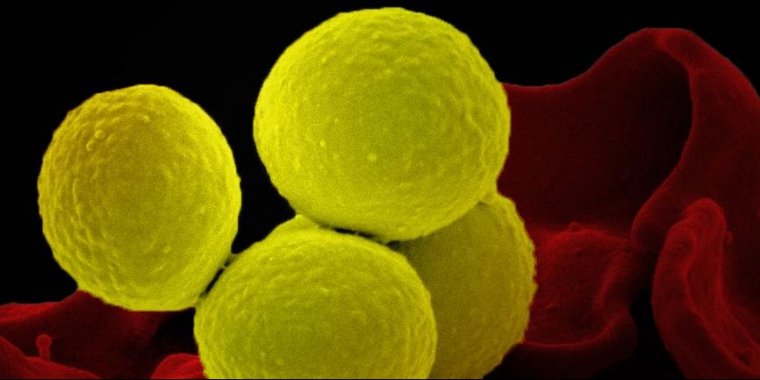| Health / Health News |
Widely-available antibiotics could be used in the treatment of ‘superbug’ MRSA
Since the discovery of penicillin, the introduction of antibiotics to treat infections has revolutionised medicine and healthcare, saving millions of lives. However, widespread use (and misuse) of the drugs has led some bacteria to develop resistance, making the medicines less effective. With few new antibiotics in development, antibiotic resistance is widely considered a serious threat to the future of modern medicine, raising the spectre of untreatable infections.

Scanning electron micrograph of a human neutrophil ingesting MRSA (yellow). Photo: NIAID
One of the most widely used and clinically important groups of antibiotics is the family that includes penicillin and penicillin derivatives. The first type of penicillin resistance occurred when bacteria acquired an enzyme, known as a beta-lactamase, which destroys penicillin. To overcome this, drug manufacturers developed new derivatives of penicillin, such as methicillin, which were resistant to beta-lactamase.
In the escalating arms race, one particular type of bacteria known as Methicillin-resistant Staphylococcus aureus – MRSA – has developed widespread resistance to this class of drugs. MRSA has become a serious problem in hospital- and community-acquired infections, forcing doctors to turn to alternative antibiotics, or a cocktail of different drugs which are often less effective, and raises concerns that even these drugs will in time become ineffective.
In previous research, a team of researchers in Cambridge identified an isolate of MRSA (a sample grown in culture from a patient’s infection) that showed susceptibility to penicillin in combination with clavulanic acid. Clavulanic acid is a beta-lactamase inhibitor, which prevents the beta-lactamase enzyme destroying penicillin; it is already used as a medicine to treat kidney infections during pregnancy.
A team of scientists identified a number of mutations (changes in the DNA sequence) centred around a protein known as a penicillin-binding protein 2a or PBP2a.
PBP2a is crucial to MRSA strains as it enables them to keep growing in the presence of penicillin and other antibiotics derived from penicillin. Two of these mutations reduced PBP2a expression (the amount of PBP2a produced), while two other mutations increased the ability of penicillin to bind to PBP2a in the presence of clavulanic acid.
Overall the effect of these mutations means that a combination of penicillin and clavulanic acid could overcome the resistance to penicillin in a proportion of MRSA strains.
The team then looked at whole genome sequences of a diverse collection of MRSA strains and found that a significant number of strains – including USA300 clone, the dominant strain in the United States – contained both mutations that confer susceptibility. This means that one of the most widespread strains of MRSA-causing infections could be treatable by a combination of drugs already licensed for use. (University of Cambridge)
YOU MAY ALSO LIKE


